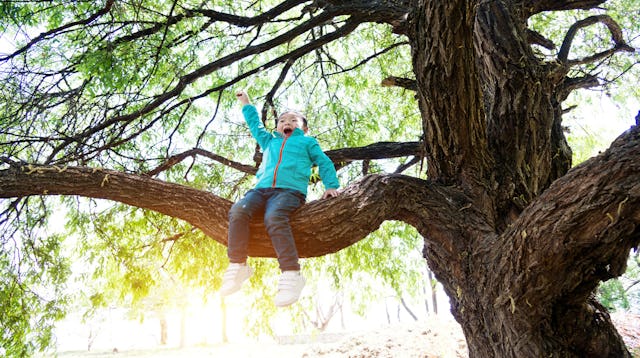Could Adventure Playgrounds Be The Antidote To Helicopter Parenting?

Imagine you take your kid to one of those so-called adventure playgrounds you’ve heard about. A mop-top blond six-year-old is setting something on fire. Another kid is hammering. Another is sawing — and the saw isn’t made of plastic. Someone else is rolling a tire and yet another is yanking stuffing from a derelict armchair. Would you stay long? Would you run far, far away? Or would you call the cops?
There are eight adventure playgrounds in the United States, according to Lifehacker, and include zip lines, tire swings, saws, rope swings, trees to climb, rafts, mudslides, water pumps, “loose parts,” “discarded materials,” straw bales, and encouragement for worm digging. Some sites require a waiver. Some require an adult to be within arm’s length of those under seven. Some encourage adults to stay outside the fence. Playgrounds like this are all over Europe, but liability makes it hard to have them stateside.
Most of us are too busy hovering to let our kids throw pinecones or build a fort, let alone saw things in half — very different from our childhoods, when, at age eight, I had full run of a two-mile radius around my house, including roads, a creek we regularly tried to dam, and a rope swing.
Some call it “free range parenting,” but it used to just be “parenting” — until sometime around the mid-1980s. There are many reasons for that, but they include an increase in the sensationalism of child abduction and violent crime, a push for higher educational standards (which came with a rise in extracurriculars), and, according to The Atlantic, an era of rising lawsuits over “potentially dangerous playground equipment.”
We were scared. We had to protect our kids — from the big bad world waiting to kidnap and murder them. From failing out of school. From tripping and falling and hurting themselves. We are their parents. It’s our job, right?
Not really, advocates and “child minders” on adventure playgrounds would argue. Risky play — not actual trauma, danger, or abuse, but play — can “build social skills and encourage creativity,” say many studies, according to NBCNews. Dr. Stuart Brown, psychologist and founding director of the National Institute for Play to NPR, says kids need “the opportunity to engage in open, free play where they’re allowed to self-organize … It’s really a central part of being human and developing into competent adulthood.” The kind of play on adventure playgrounds is essential, he says.
Parents are busy interacting with their cell phones instead of playing with their kids, another adventure playgrounds advocate, Patty Donald, tells NPR. “I find there are a lot of adults who don’t know how to play with their kids,” she says — because their kids are so overscheduled and coddled, they don’t really sit down and play with them. Even worse, one study detailed in The Atlantic found that, ironically, our fears that children won’t be safe actually creates fearful children. Risky play, instead, encourages confidence.
So how do we get more parents to buy into the benefits of adventure playgrounds?
Kids adore them. They often beg for a few more minutes, notes almost every article on the topic, and always seem to have a blast playing on their own, taking risks, doing things they wouldn’t normally “be allowed” to do. And injuries are few. Play minders step in “like lifeguards,” they tell NBCNews, if needed, but that happens very seldom. If parents saw how much fun their kids had on the playgrounds, would that change their minds? Would they allow their children more freedom?
Or would they have to put themselves in their kids’ shoes — look at the playground and imagine themselves at six, eight, ten years old? Know how much fun they had damming creeks, climbing trees, roller-skating down an empty sidewalk, aimlessly bike riding for miles? Do they remember the forts they built? Do they remember trying to use their parents’ tools to make them?
If they can remember, they can let their kids loose on an adventure playground. And maybe, if they can see their child bloom in the absence of a hovering adult, they’ll take the first steps to letting go a bit. Maybe their kid can pay for their candy themselves. Maybe they can walk down the block alone. Maybe we can all begin to helicopter a little less, value play a little more. And maybe these adventure playgrounds can help us do it.
This article was originally published on